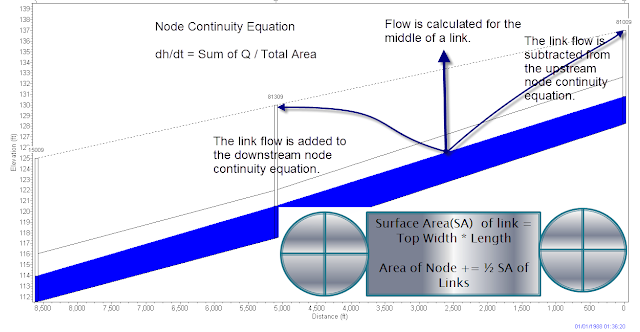Link and Node Basics in SWMM 5
Fundamental components of any SWMM 5 model: links and nodes. These elements are essential for representing the physical infrastructure of a drainage system and simulating how water flows through it.
Nodes
- What they are: Nodes are points within the drainage network where water flows converge or diverge. Think of them as junctions, manholes, or points of interest within the system.
- Types of nodes:
- Junctions: The most common type, representing points where pipes connect.
- Outfalls: Points where water exits the system, such as discharge into a river, lake, or treatment plant.
- Storage Units: Represent detention ponds, reservoirs, or other storage facilities.
- Dividers: Nodes that split incoming flow into two or more outgoing pipes based on specified rules.
Links
- What they are: Links are the conduits that convey water between nodes. They represent the pipes, channels, or other conveyances in the drainage system.
- Types of links:
- Conduits: The most common type, representing pipes or channels with various shapes, sizes, and materials.
- Pumps: Used to lift water from lower to higher elevations.
- Orifices: Represent small openings that control flow, such as those found in weirs or underdrain systems.
- Weirs: Used to model overflow structures or flow control devices.
Key Concepts
- Connectivity: Nodes and links are interconnected to form the drainage network. Water flows from upstream nodes, through links, and into downstream nodes.
- Elevation: The elevation of nodes and the invert elevation of links are crucial for determining flow direction and hydraulic grade lines.
- Hydraulic Properties: Links have hydraulic properties like diameter, roughness (Manning's n), and length, which influence flow calculations.
- Flow Routing: SWMM 5 uses various methods to route flow through links and nodes, including steady-state, kinematic wave, and dynamic wave routing.
Why They Matter
- Network Representation: Nodes and links are the building blocks for representing the physical layout and characteristics of the drainage system in SWMM 5.
- Flow Simulation: They are essential for simulating the movement of water through the system, including flow rates, water depths, and velocities.
- System Analysis: By analyzing the behavior of links and nodes, you can identify potential bottlenecks, surcharge risks, and areas for improvement in the drainage system.
Example
Imagine a simple system with a subcatchment draining into a pipe that leads to a manhole. In SWMM 5:
- The subcatchment would be connected to a junction node.
- The pipe would be represented as a Conduit link.
- The manhole would be another junction node.
- If the manhole discharges to a river, the river would be represented by an outfall node.
By understanding the basics of links and nodes in SWMM 5, you can effectively build, analyze, and interpret models for stormwater management, flood prediction, and drainage system design.


